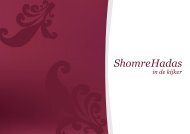You also want an ePaper? Increase the reach of your titles
YUMPU automatically turns print PDFs into web optimized ePapers that Google loves.
בס''ד<br />
The Shomre Hadas <strong>Seder</strong> <strong>Handbook</strong><br />
enactments were made with the explicit purpose of “keeping the<br />
children awake.” A child, furthermore, is customarily singled out to<br />
ask the Four Questions, and the Haggadah makes explicit reference<br />
to four sons, each of whom is addressed in turn.<br />
One needs to be innovative in order to keep the children awake.<br />
It is said that Rabbi Akiva would give out nuts on Erev Pesach so that<br />
the children should not fall asleep, but would ask questions. Rabbi<br />
Eliezer stated, “One grabs [and hides] the matzah on the night of<br />
Pesach in order that the children should not fall asleep.” (Talmud Bavli<br />
(Babylonian Talmud), Pesachim 109a)<br />
Many of the customs at the <strong>Seder</strong> are designed to go against the<br />
norm in order to pique the curiosity of the children. Washing hands<br />
at the table, dipping food in salt water, breaking the matzah and<br />
putting it away for later – all these elements of the <strong>Seder</strong> serve to<br />
catch the attention of the children.<br />
Part of the reason that the Passover <strong>Seder</strong> is such a powerful<br />
educational tool is that it doesn’t rely on mere storytelling to convey<br />
its point. Instead, it presents children with tangible experiences and<br />
actions to cement its powerful lessons. A popular expression states<br />
that a picture is worth a thousand words. An action or example may<br />
be worth much more than that. The following story illustrates an<br />
incident in which parents communicated their values to their children<br />
through actions rather than words, creating a lasting experience that<br />
their children would remember forever.<br />
The Lovitz family was a fine family, and their children were<br />
outstanding students and an asset to the yeshivah where they<br />
attended school. Their parents had raised them with incredible<br />
strength of character and a clear sense of right and wrong. The<br />
family, however, was poor, and barely able to pay the private school’s<br />
26



